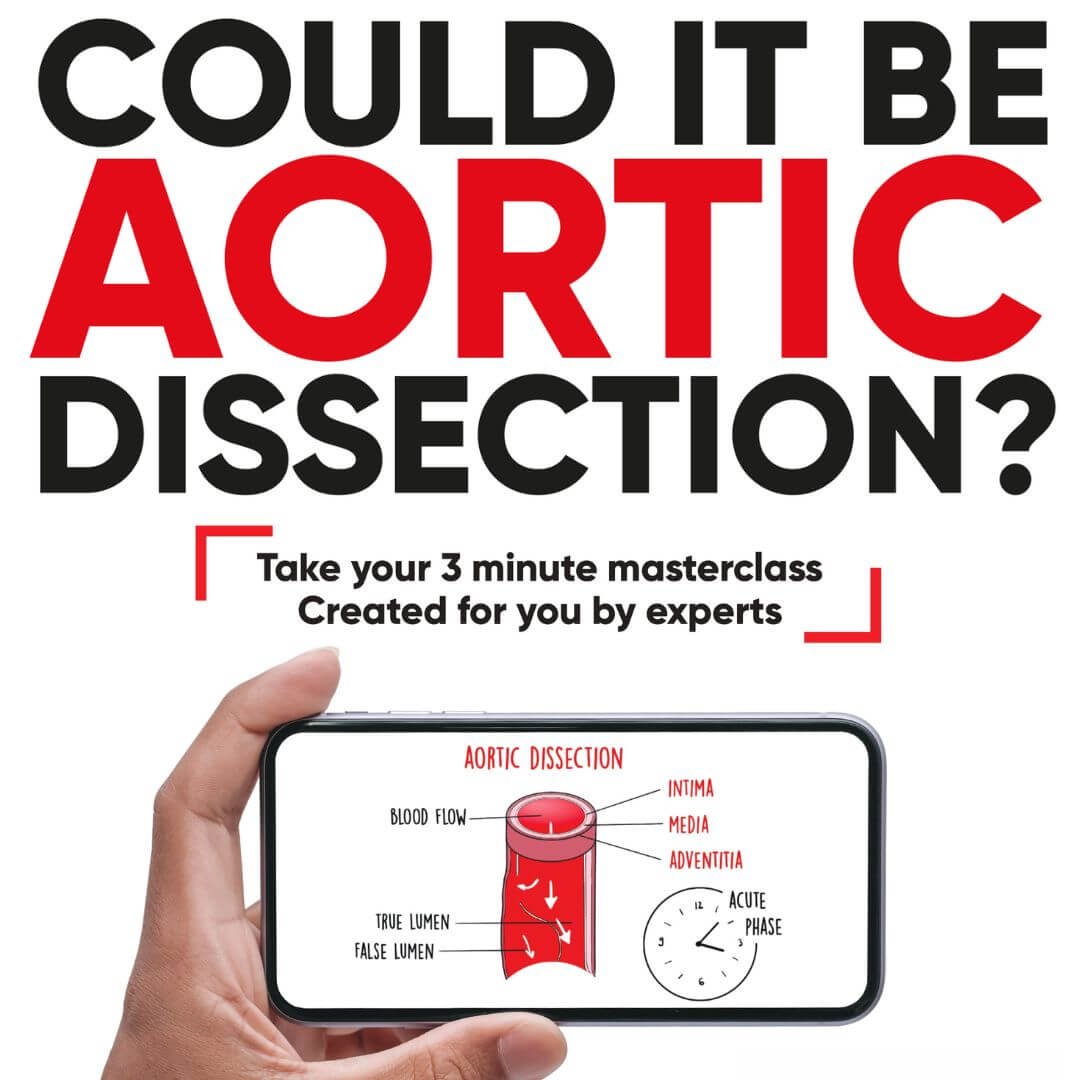The DAShED research project, an observational cohort study funded by the Royal College of Emergency Medicine (RCEM), led by Matt Reed, a consultant in emergency medicine in Edinburgh, represents a significant effort to improve the diagnosis and management of aortic dissection in emergency departments. Emergency doctors face substantial challenges with Acute Aortic Syndrome due to its varied presentation and overlap with other conditions. Accurate and timely diagnosis is essential, yet difficult, often requiring complex decision-making processes and advanced imaging techniques.
The primary aim of the DAShED study was to describe the characteristics of patients presenting with symptoms potentially indicative of aortic syndromes and to gather evidence on the efficacy of existing clinical decision tools. These tools are designed to help doctors assess the likelihood of aortic dissection and make informed decisions about further testing, such as CT scans. By involving 27 emergency departments across England, Scotland, and Wales, the study ensured a comprehensive and representative data set.
The study addressed a critical gap in existing research, which had previously focused more on managing diagnosed aortic dissections rather than the initial diagnostic process in a broad emergency department setting. Through a combination of prospective and retrospective data collection, the DAShED study sought to capture the real-world complexities and nuances faced by clinicians when assessing patients with potential aortic syndromes. The findings of this study provide valuable insights into the current diagnostic landscape and highlight areas for future research and improvement in emergency medicine practices.
Key Insights and Challenges
Strengths:
- The study involved 27 emergency departments across the UK, ensuring a diverse and representative patient sample.
- Good engagement from clinicians highlighted the importance and relevance of the research.
- The study was the first to examine aortic dissection in a wide emergency department population, rather than specific centres or already diagnosed cases.
- The use of REDCAP and QR codes facilitated efficient data collection.
Limitations:
- A large proportion of patients were recruited retrospectively, which might affect the data’s reliability.
- The study could only include data from tests that were already part of routine clinical care, limiting the scope of findings.
- There might have been missed cases, although efforts were made to minimise this risk.
- Applying clinical decision tools retrospectively in some cases could introduce bias.
Next Phase of the Study: DAShED2
With the findings and limitations of the DAShED study in mind, Matt announced the next phase of the research. Supported by the Aortic Dissection Charitable Trust, a grant proposal has been submitted to the NHS to further explore and address these diagnostic challenges. This process involves multiple stages, including a priority-setting exercise, before the grant can be awarded.
The upcoming study will involve a multidisciplinary team, including experts from emergency medicine, radiology, vascular surgery, thoracic surgery, health economics, and qualitative research. Patient and public involvement will also be integral to the study, ensuring that patient perspectives on diagnostic decisions are considered.
The study will focus on patients presenting with symptoms potentially indicative of aortic dissection. Those who are clearly identified as low-risk or high-risk by clinicians will not be enrolled. Instead, the study will target the intermediate group – patients for whom the clinician has not ruled out aortic dissection but does not feel there is enough evidence to immediately warrant a CT scan.
These patients will be randomised into two different care pathways. One pathway will follow the Royal College of Emergency Medicine guidelines, using the ADD-RS score to determine if a CT scan is necessary. If the patient does not exhibit high-risk features, a D-dimer test will be performed. If the D-dimer test is positive, the patient will then undergo a CT scan. This approach aims to balance the sensitivity of detecting aortic dissection with the practicality of not overusing CT scans.
The study aims to validate whether this combined approach can effectively reduce the need for unnecessary CT scans while still accurately identifying aortic dissections. Success in this trial could lead to the implementation of this diagnostic pathway across emergency departments in the UK, ultimately improving patient outcomes and resource utilisation.
To learn more about the next phase of this research, watch the recording of our recent webinar. This session details DAShED2 objectives and the vital role it plays in improving aortic dissection diagnosis and management.
Webinar Q&A Highlights
-
Did you look at the tendencies to confuse aortic dissections with other diagnoses? Which other diagnoses should be double-checked because of the likelihood of confusion with aortic dissection?
The study did not specifically examine missed cases of aortic dissection, though delayed diagnoses were observed. Common misdiagnoses occur when doctors assume the patient is having a heart attack, leading to a lack of consideration for aortic dissection. Often, the initial focus is on proving a heart attack, and elevated blood test results can reinforce this misdirection. Sometimes, aortic dissection is not included in the differential diagnosis, or the right tests are not performed, and occasionally, it is simply not thought of at all. The key to improving diagnosis rates is increasing awareness among emergency department staff about aortic dissection, ensuring it is always considered as a potential diagnosis.
Regarding the confusion with alcohol-related symptoms, while specifics can vary, it is recognised that symptoms might be attributed to alcohol use, leading to misdiagnosis. This multifactorial issue involves not recognising the symptoms or not giving them enough weight, resulting in a failure to consider aortic dissection. Although attributing confusion and drowsiness to alcohol is less common now due to increased awareness, it can still happen. Increased education and awareness among clinicians are essential to reducing these occurrences.
-
Do you think that the symptoms from malperfusion caused by an aortic dissection can add to the confusion when it comes to diagnosis?
Absolutely. Patients who present with strokes or mini-strokes can appear to have a stroke, and we may treat them accordingly. This can be the only symptom of an aortic dissection if the dissection has affected the carotid vessels, leading to stroke-like symptoms. However, there are often additional factors that do not align perfectly with a typical stroke. For instance, a patient with a stroke is usually fully responsive, whereas a significant dissection presenting with stroke symptoms tends to result in the patient being less responsive than they would be with a conventional stroke.
-
Is there any data showing a difference in the success rates of diagnosing aortic dissection in patients presenting with documented classical stroke symptoms compared to those without? Do you think there is a difference in the diagnosis success rate across these two groups?
That is a very interesting question. We tried to examine this in the DAShED study by looking at the symptoms presented by patients to determine if certain symptoms were more likely to indicate an aortic syndrome. However, we faced limitations as only 14 out of the 6,000 recruited patients had an aortic syndrome. To answer this question thoroughly, we would need to conduct retrospective studies, reviewing the medical records of patients who had an aortic dissection to identify their presenting symptoms. This requires analysing hundreds of cases or conducting more comprehensive emergency department studies and combining the data. Additionally, using AI and data analysis could help. There is ongoing research funded by the charity that aims to combine data from patients with aortic dissection with DAShED study data to better identify key symptoms that should be closely monitored.
-
Considering the roles of AI, clinical decision-making tools, biomarkers, and genetics, where do you think future success will come from in achieving more successful diagnosis of aortic dissection?
This is a very interesting question. The timeline for these advancements is crucial. In the short term, within the next five years, I hope we will develop a clinical decision rule based on patient characteristics and possibly D-dimer, as proposed in DAShED2. While we have investigated various biomarkers for aortic dissection, unfortunately, none, except for D-dimer, have shown significant potential. D-dimer’s effectiveness is promising, and the focus is now on how to utilise it best.
Looking further ahead, I believe we will discover a more specific biomarker for aortic dissection. Reflecting on the evolution of heart attack management, we initially used several markers with limited accuracy, relying on clinical decision rules. Now, we have troponin, a highly sensitive marker that has revolutionised cardiac care. I am hopeful that within ten years, we will find a similar marker for aortic dissection.
In terms of personalised medicine, I foresee that in 10 to 15 years, emergency departments will utilise rapid DNA tests to identify individual risks, aiding in diagnosis and treatment. Additionally, advancements in data analytics and AI will enhance the collection and integration of patient data from various sources, such as GPs, out-of-hours teams, and ambulance services, improving our diagnostic tools. Combining these approaches will significantly improve our ability to diagnose aortic dissection accurately.
-
In the scenario where a patient was picked up by an ambulance with suspected aortic pain, experiencing back pain, chest pain, stomach pain, a raised D-dimer, a normal echocardiogram, and fluctuating blood pressure, would you have sent them for a CT scan based on these symptoms?
That is a very difficult question. Presuming the patient had an aortic dissection, it is easier to see in retrospect that the symptoms of chest pain, back pain, raised D-dimer, and hypertension were clearly related to aortic dissection. This case highlights the challenges in diagnosing this condition. It is not possible to comment specifically on why it was missed in this case, but it underscores the need for improved diagnostic processes.
There are many similar stories where symptoms are not fully appreciated, leading to missed diagnoses. It is difficult to determine the exact reason it was missed without more information. The possibilities include not considering aortic dissection as a diagnosis, performing the wrong tests, or misattributing the symptoms to other conditions such as a heart attack or pulmonary embolism.
Regarding the echocardiogram, while it can be a good test for detecting aortic dissection, it is not definitive for ruling it out. About 5-10% of patients with aortic dissection can be identified via an echocardiogram in the emergency department. However, a normal echocardiogram does not rule out the possibility of aortic dissection, indicating the necessity for a CT scan in such symptomatic cases.
-
Will DAShED2 compare the ADD-RS with the CCPG plus D-dimer in low-risk patients?
Yes, DAShED2 will essentially compare standard care, as outlined by the Royal College of Emergency Medicine guidelines, which use the ADD-RS. Specifically, for low-risk patients who score only one point on the ADD-RS, they will be randomised to either receive a D-dimer test or not, before proceeding to a CT scan. This comparison aims to evaluate if this new approach might offer a better management strategy than the current standard.
Although it would be ideal to compare all the different rules available, the study will collect data on all these rules in the background. This way, if the Canadian rule with D-dimer proves superior, it can be compared with the other rules as well. Importantly, the study will test this approach in a real-life setting, requiring clinicians to make decisions and perform scorings upfront, rather than retrospectively.
-
From a systems perspective, what would be the implications of providing a CT scan for every patient with chest pain? How would this impact the system, patient flow, and patient outcomes?
This is a complex issue. Providing a CT scan for every patient with chest pain is not just about funding or space. Even if the NHS had unlimited funding and multiple CT scanners with radiologists available to interpret the scans, it would not be appropriate to scan everyone. There are inherent risks associated with CT scans, including the risk of cancer from radiation exposure. We must balance the need to detect aortic syndromes with the potential harm from unnecessary scans.
Medicine constantly involves weighing benefits against risks. For example, medications have side effects, and similarly, CT scans can reveal incidental findings that may not be relevant but require follow-up. For instance, a scan might detect lung nodules that are benign but necessitate annual scans for life to monitor for changes. This not only increases the workload but can cause unnecessary anxiety and additional procedures for the patient.
Moreover, scans can uncover findings we do not know how to manage. A brain scan might reveal a small aneurysm unrelated to the initial reason for the scan. Such incidental findings pose a dilemma since the risks of surgery might outweigh the benefits, yet knowing about the aneurysm makes it challenging to leave it untreated.
Increased access to scans can have positive outcomes, as unexpected but clinically significant conditions may be detected early, as was the case in the DAShEd study where a patient’s pneumonia was identified. However, the system must carefully consider the balance between thoroughness and overdiagnosis, ensuring that the benefits of scanning outweigh the potential harm and resource utilisation.
-
Is there a place for genetic testing in studies where more than one family member has been affected by AAD?
While genetic testing is not my area of expertise, it absolutely has a place in these studies. Understanding the genetic predisposition to aortic dissection can significantly improve our ability to identify at-risk individuals. For example, only about half a percent of patients in the DAShEd study had pre-existing conditions that raised suspicion for aortic dissection. If we can screen individuals with a family history of the condition, we can monitor them more closely and potentially detect deterioration before it becomes critical.
Genetic testing could revolutionise how we manage at-risk patients. Similar to how screening for aortic aneurysms has drastically reduced emergency cases by identifying and treating the condition early, genetic testing could allow for proactive monitoring and intervention. Knowing that a patient has a genetic predisposition would heighten our awareness and likelihood of diagnosing aortic dissection promptly.
With further research, we will likely identify more genes associated with aortic dissection, enabling us to screen and monitor families more effectively. This proactive approach could significantly reduce the incidence of aortic dissection emergencies, providing better outcomes for patients and their families. The charity’s support and advocacy for genetic testing and effective follow-up care play a crucial role in advancing this field.




